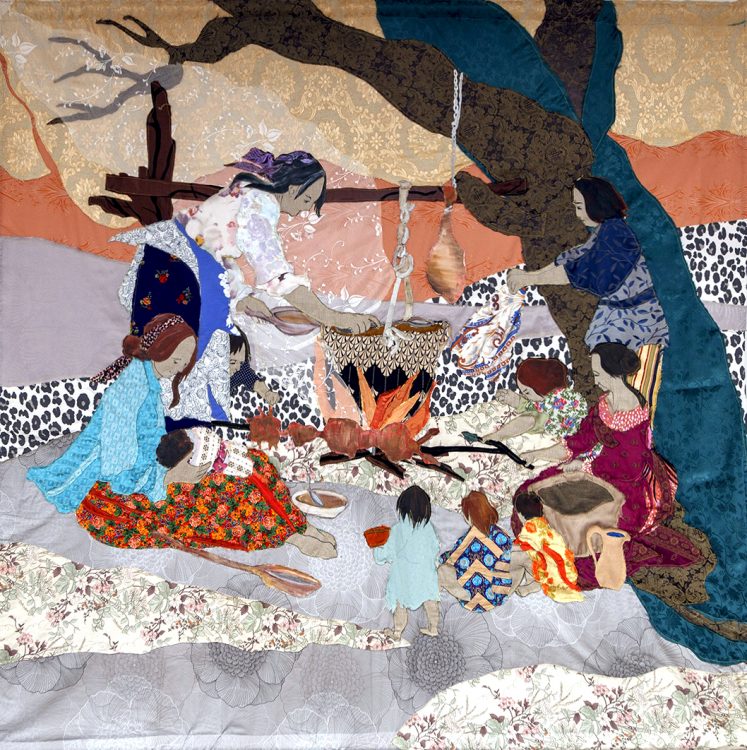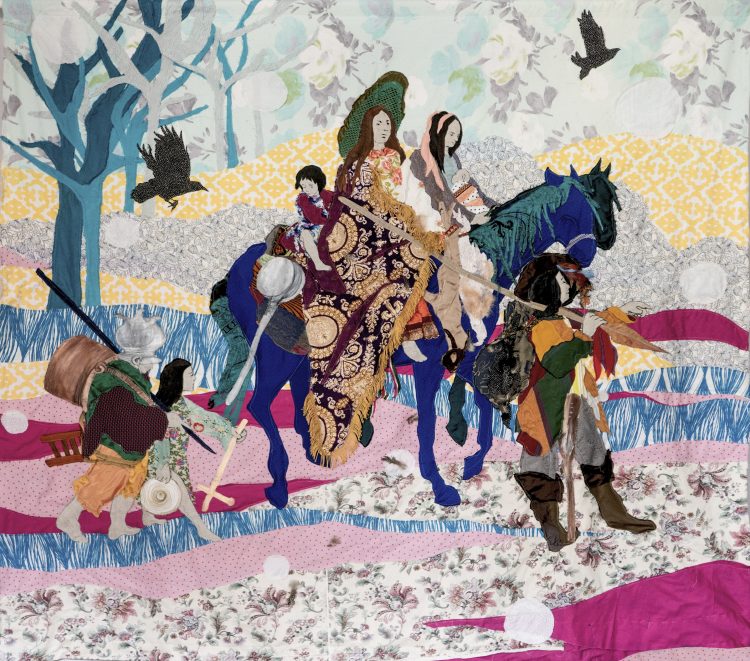Roma at the Venice Biennale

Małgorzata Mirga-Tas: from the series “Out of Egypt”, 2021, tapestry, 230 x 230 cm. Courtesy of the artist.
The selection of Małgorzata Mirga-Tas to represent Poland at the 59th International Art Exhibition at the Venice Biennale is a great step forward for Roma contemporary art, Roma recognition and for the Roma people. Mirga-Tas has been exhibiting internationally for many years to great acclaim, and this opportunity is a fitting milestone in the artist’s career trajectory, but also an exciting development in the story of the Roma at the Venice Biennale. As ERIAC and RomaMoMA lobby further toward a permanent home for Roma at the Venice Biennale, the inclusion of one of our great cultural producers in the elite Giardini setting is a most welcome boost. Yes, the Biennale is an elitist institution. Yes, it seems remote from the situation for Roma on the ground, but it is also where governmental policy can be influenced and international perceptions persuaded toward alternative points of view.
Roma presence at the Venice Biennale contributes to the preservation of Roma cultural capital by promoting narratives that can be influential in changing attitudes. Our presence also helps to build alliances with like-minded organisations, as well as representing a quantifiable enhancement of contemporary art discourse in terms of diversity—a much needed state of inclusion which contemporary art networks are coming to rather late in the day. The art world is an unwieldy entity, which takes time to interpret and react to societal change. It therefore often trails behind other more immediate instruments in reflecting and mediating on-going and emerging inequalities within society. Consequently, the contemporary state of play is often slow to be mirrored within contemporary art networks—indicating a reluctance to look beyond the customary circuits of galleries, art fairs and biennales to find fresh approaches. Relying upon a limited range of influence and opinion may suit the reliably market-led art world, but it will not necessarily reflect the range or quality of work being produced at any given time. This is why events like the Roma exhibition at the Venice Biennale, now made possible through the independent fundraising of ERIAC, are so important in putting forward voices that are regularly missing from fashionable art routes and blinkered contemporary art networks.
Positive visibility remains a key issue for Roma communities. Negative images of Roma continue to circulate, based on historically prejudiced perceptions, and these still need to be countered with alternative examples of Roma culture and Roma life. Contemporary art platforms like biennales can further promote positive visibility by engaging with wider society in terms of showcasing the realities of the Roma experience and the value of Roma culture. They also serve the purpose of giving artists from Roma communities a path of professional development through which to further their careers, as well as the chance to make an impact upon the wider discourse. The immediacy of contemporary art platforms also presents opportunities for Roma to become part of public debate in ways that are often less confrontational than other means. No matter how extreme the message, or the action, it can still be viewed as less a point of conflict within the art world than in other settings. This offers a safer space to explore highly charged political, emotional, cultural and generational questions, thereby enhancing connection across difference and promoting solidarity and confidence, whilst at the same time foregrounding the intersectionalities that underpin much of today’s Roma artistic production. Art presented within the right context can promote enquiry, offer hope and present alternative possibilities for us all. By emphasising the universality of the Roma experience, art has the potential to convey meaning through conceptual and experiential means, which can perhaps relax obstacles to understanding.
Although it can be said that the promotion of art practices attached to a specific identity position can be limiting, especially if their meanings are only relatable within a particular context, I believe that good art can operate within multiple contexts and continue to convey meaning and insight in a variety of situations—transcending their labels whilst at the same time embracing them. FUTUROMA, the third Roma Exhibition at the Venice Biennale, which I curated in 2019, aimed to present an example of this by staging works which carry universal meaning, whilst also being grounded within a particular subjectivity. The selection of Małgorzata Mirga-Tas to represent Poland at the upcoming Biennale in Venice is a further example of this universality, and shows that art by Roma people is breaking through the barriers that have been in place for far too long. Let us hope that this progressive move can help toward addressing the persistent absence of works by Roma artists in museum programming and in important public collections: a state that reflects a lack of commitment to addressing inequalities within the art establishment—and is of course a direct reflection of Roma inequality within wider society.
Exposure to work by Roma artists at high-profile contemporary art events offers Roma people a chance to see themselves reflected within major institutions—an experience which is all too often lacking in encounters with mainstream society. These occasions give focus to Roma issues and Roma values by enabling Roma networks to establish and flourish. They also set an example to young people who may not have considered art as a viable career option in a profession that seems remote from their own experience. Here, we witness artists owning the various aspects of their identity and becoming much more than the sum of those parts – demonstrating that every part of us has a part to play in our personal and professional development. When we are encouraged to explore our identities fully, we are able to access our full potential, and the integration of those often divergent or conflicting parts equips us with skills for navigating the complexities of full engagement with the wider world. Many Roma artists eloquently navigate such seemingly complex mechanisms in engaging and surprising ways. It is fitting, therefore, that these artistic practices are starting to be presented in elite programming on a level playing field alongside the best of the rest in the world. This in itself is a great achievement, but there is still a long way to go.

Małgorzata Mirga-Tas: from the series Out of Egypt, 2021, tapestry, 230 x 246 cm. Courtesy of the artist.
Post Script
I cannot help but think that the momentous shift that has now occurred with a Roma artist representing a national pavilion at the Venice Biennale is due not only to the extraordinary talent of the artist and curators, but also in no small degree to the visionary approach of those selecting the winning entry. Among these was Zachęta, Poland’s National Gallery of Art, and its Director, Hanna Wróblewska, under whose watch I have been involved in two exhibitions: Houses as Silver as Tents in 2013, curated by Monika Weychert Waluszko, and The Travellers in 2016, curated by Magdalena Moskalewicz. Both these Zachęta shows broke new ground in their own way, in terms of rethinking Roma representation, and notions of inclusion and exclusion, to great effect. As a key player within the Polish Pavilion selection process, I have no doubt that Zachęta’s involvement has smoothed the way for the welcome result that we witness today. It is with some irony, then, that such a progressive moment comes when its Director has been effectively dismissed by the current Polish government, who have stated that Wróblewska’s contract will not be extended beyond next year. For some, innovative thinking and action spells danger rather than progress, as has been the case for Roma innovation for generations. Let us hope, then, that the progress made in the choice of a Roma artist for the Polish Pavilion in 2022 can be taken forward as a beacon of hope for the future, despite the prejudices that continue to proliferate.
Daniel Baker

[…] Next Blog Entry […]
[…] Previous Blog Entry […]
[…] Képjegyzék:Borítókép és 1-2. kép: Rony Plesl – Trees Grow from the Sky, installáció (munkafolyamat), 2022 © Rony Plesl, Fotó: Petr Krejci3. kép: Rony Plesl portréja © Rony Plesl, Fotó: Petr Krejci6. kép: Małgorzata Mirga-Tas – Re-enchanting the World, textil-installáció (részlet), 2022. Fotó: Bartek Solik7. kép: Małgorzata Mirga-Tas – Esma Redźepova / Herstories, patchwork (részlet), 2021. Forrás: Vogue Polska8-9. kép. Małgorzata Mirga-Tas – az Out of Egypt sorozatból, faliszőnyeg, 2021. Forrás: European Roma Institute […]
[…] Photos:Cover photo and images 1-2: Rony Plesl—Trees Grow from the Sky, installation (work process), 2022 © Rony Plesl, Photo: Petr KrejciImage 3: Portre of Rony Plesl © Rony Plesl, Photo: Petr KrejciImage 6: Małgorzata Mirga-Tas—Re-enchanting the World, textile installation (detail), 2022. Photo by Bartek SolikImage 7: Małgorzata Mirga-Tas—Esma Redźepova / Herstories, patchwork (detail), 2021. Source: Vogue PolskaImages 8-9: Małgorzata Mirga-Tas—from the Out of Egypt series, tapestry, 2021. Source: European Roma Institute […]